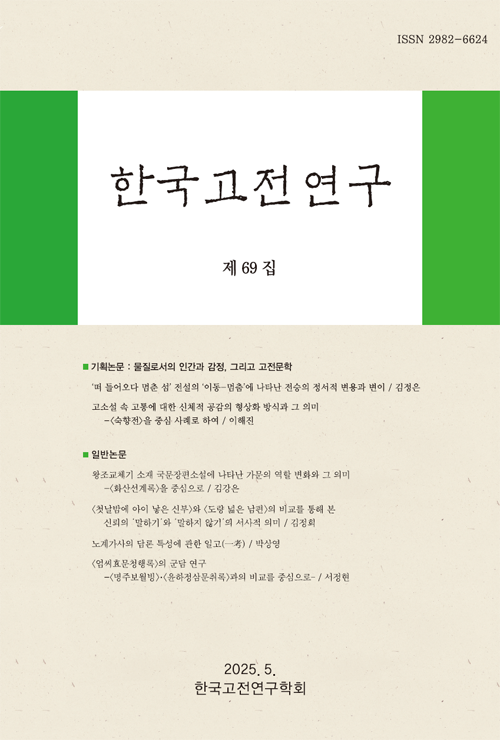- 영문명
- Stylistic and Persuasive Strategies in Buddhist Exhortation Texts by Joseon Monks in the Late Joseon Period
- 발행기관
- 한국고전연구학회
- 저자명
- 전선영(Sun-young Jeon)
- 간행물 정보
- 『한국고전연구(韓國古典硏究)』제70권, 123~164쪽, 전체 42쪽
- 주제분류
- 인문학 > 문학
- 파일형태
- 발행일자
- 2025.08.31
7,840원
구매일시로부터 72시간 이내에 다운로드 가능합니다.
이 학술논문 정보는 (주)교보문고와 각 발행기관 사이에 저작물 이용 계약이 체결된 것으로, 교보문고를 통해 제공되고 있습니다.

국문 초록
본고는 조선후기 간행 승려문집에 수록된 권선문(勸善文)을 대상으로 하여, 그 문체와 서술방식의 양상을 분석하고자 하였다. 조선후기 불교계는 전란과 재해로 수행 기반이 약화된 상황에서, 사찰의 중창과 불사 추진이 긴급한 과제로 대두되었으며, 이에 시주를 유도하고 불사의 정당성을 알리는 수단으로 권선문이 활발히 작성되었다. 권선문은 불사의 필요성과 시주의 당위성을 설득하기 위한 글로서 일정한 형식을 갖추면서도, 작성자와 수신자, 불사 대상에 따라 다양한 표현 방식이 구사된다. 대부분의 권선문은 불사의 발원 동기, 대상의 가치, 보시 권유, 회향과 축원의 흐름으로 구성되며, 개별 문헌에서는 경전 인용, 문답체 구성, 감응 중심의 서사 등 다양한 수사 전략이 활용된다. 특히 승려가 작성한 권선문에서는 요청을 전달하는 데 그치지 않고, 발원의 마음을 서사화하며 신앙 공동체의 참여를 호소하는 표현이 두드러진다. 이러한 경향은 권선문의 작성자 다수가 실제로 불사를 주관했던 고위 승려들이었다는 점에서도 확인되며, 그들이 남긴 권선문은 개인의 문장력을 넘어 교단의 이상과 현실적 과제를 함께 반영하는 기록물로 기능하였다. 본고는 조선후기 승려문집 35종에 수록된 권선문 200여 편을 전수 조사하여, 불사 대상과 수신자에 따른 서술 방식의 차이를 살피고, 승려들의 불사 인식과 신앙적 태도가 글쓰기 안에서 어떻게 구현되었는지를 분석하였다. 이를 통해 권선문이 단순한 시주 요청문을 넘어, 불교의 교리와 현실 대응, 수행자의 신앙과 공동체의 실천 의지를 아우르는 복합적인 성격의 실용 산문으로서, 문학적 가치를 함께 지닌 양식이었음을 밝히고자 하였다.
영문 초록
This study examines the stylistic and rhetorical characteristics of Gwonsunmun (勸善文, Buddhist exhortatory texts) included in Seungnyeo Munjip (僧侶文集, Buddhist monastic anthologies) published in the late Joseon period. During this time, amid the devastation caused by war and natural disasters, the restoration of temples and the promotion of Bulsa (佛事, Buddhist public works) became pressing concerns for the Buddhist community. Gwonsunmun emerged as persuasive texts designed to solicit donations and justify the necessity of such religious endeavors. While these texts followed a relatively consistent structure—typically comprising the motive of the project, the sacred value of the target, exhortation to donors, and closing benedictions—they also reveal considerable variation depending on the author, recipient, and nature of the bulsa. Through a comprehensive survey of approximately 200 Gwonsunmun texts preserved in 35 monk-authored collections, this study analyzes how Buddhist doctrinal references, narrative persuasion, and rhetorical techniques such as dialogue and karmic analogies were mobilized to suit different audiences. In particular, texts authored by monks often go beyond mere requests for support, articulating the initiator’s spiritual intention and appealing to a sense of communal religious responsibility. Many of the authors were high-ranking monks actively involved in the actual execution of bulsa projects, and their writings reflect both personal literary agency and the institutional concerns of the Buddhist monastic community. This study argues that Gwonsunmun functioned not only as practical documents for religious fundraising but also as literary expressions that intertwined doctrinal conviction, lived religious practice, and collective engagement.
목차
1. 머리말
2. 권선문의 개념과 승려문집 수록의 배경
3. 권선문의 형식과 문체적 특징
4. 권선문의 서술방식과 설득전략
5. 맺음말
참고문헌
해당간행물 수록 논문
- 강을생본 <허웅애기본풀이>에 나타난 사별 애도 과정과 의미 - 영화 <원더랜드>(2024) 속 모녀 관계와의 비교를 겸하여
- <세경본풀이>의 통사론적 규칙과 서사 의미론
- 조선후기 승려 권선문의 문체와 설득 전략
- 남유용의 회화 감상과 시적 형상화에 나타난 심미 의식
- 뇌과학적 관점에서 본 감정과 고전문학
- 남성으로 묻힌 열녀절부(烈女節婦) - 〈방한림전〉에서 유교 덕목을 통해 보는 여성성과 남성성의 충돌
- 경판 <소대성전>의 간행 양상 재구 - 동경외대 소장 ‘30장본’을 중심으로
- 『송계잡록』수록 가사 <채란상사곡>의 문학적 형상화와 성격 고찰
- <몽옥쌍봉연록-곽장양문록> 연작의 곽분양 수용 양상과 그 의미
- <소현성록> 속 며느리 형상화와 시집살이 양상
참고문헌
교보eBook 첫 방문을 환영 합니다!

신규가입 혜택 지급이 완료 되었습니다.
바로 사용 가능한 교보e캐시 1,000원 (유효기간 7일)
지금 바로 교보eBook의 다양한 콘텐츠를 이용해 보세요!



